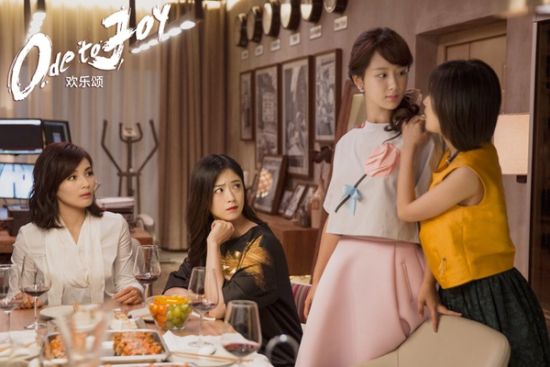‘Ode to Joy’ offers frank portrayal of middle class

A stage photo of the TV series Ode to Joy
“We had expected that Ode to Joy would stir discussion but the heatedness of the discussion has far exceeded our imagination,” said Hou Hongliang, the producer of the TV series Ode to Joy, while pointing at the website of his microblog, where there are still over 2,000 unread letters from fans of the TV series. This also nags the scriptwriter Yuan Zidan.
It seems that it has been a long time since a Chinese TV series about urban life has been capable of provoking such widespread discussion. Its finale was viewed 600 million times in the first day after it was released online, which is twice as many as Nirvana in Fire, another series that Hou produced.
“This is a risk and also a challenge to the daily concept of most Chinese,” Hou said.
The first episode of Ode to Joy was unconventional. It featured five female characters of varying ages with different dispositions, jobs and family backgrounds. The story follows the characters’ life paths as they intersect with each other.
“In normal sense, the conflicts break out in the beginning of the story, usually the first three episodes of the series and the conflicts tend to be amplified and exaggerated to gain ratings. But is that true in our own life? There are few families where squabbles and brawls occur as frequently as every two or three days,” said Yuan, who has worked as a scriptwriter for 10 years. “Portraying characters is much more difficult than designing plot. I decided to create characters that are real this time.”
“Once the characters are outlined and clearly shaped in the beginning, the whole narrative can naturally unfold and grow more complex based on the different disposition of each character,” Hou said, arguing that this style of storytelling more closely mimics real life.
Ode to Joy is widely discussed because it touches on real issues in Chinese society, such as starting up a business, changing jobs, death from overwork, the preference for male children, Internet violence and many other hot topics that can be commonly seen in the news.
Some critics of the series’ values have posed the question: How can the affluent post-1980s and post-1990s generations, who flaunt their wealth, be inspired and motivated to make progress? In response to this, Yuan explains, “In fact, each person is multifaceted in their temperament and disposition. A person is neither that good nor that bad. Our life is neither black nor white. Instead, there is much gray to it, which is between the two.” He said this is human nature in the real sense and to reflect this is one essential art of the TV series.
Literary and artistic works mirror reality. The discussions on the characters portrayed in Ode to Joy and their life values reflect social transformation in a period of transition as personal interests converge with and differ from each other.
“As a type of mass art, TV series may not be that superlative in manifesting life compared with literary drama, but we hope that TV series can be enlightening in helping people to get a clear understanding of themselves and the external world,” Hou said. “Breaking down class barriers—this is what people are often talking about, but can it be realized if you just think about it? You need to get disillusioned to achieve self-reliance.”
However, this issue is usually avoided in many Chinese TV series about urban life. They are not sharp and radical enough, Hou said. “Art means responsibility, i.e. the responsibility to let people know more about life and world,” he said. “Realism is what Ode to Joy adopts, which we hope can be thought-provoking for the audience.”
